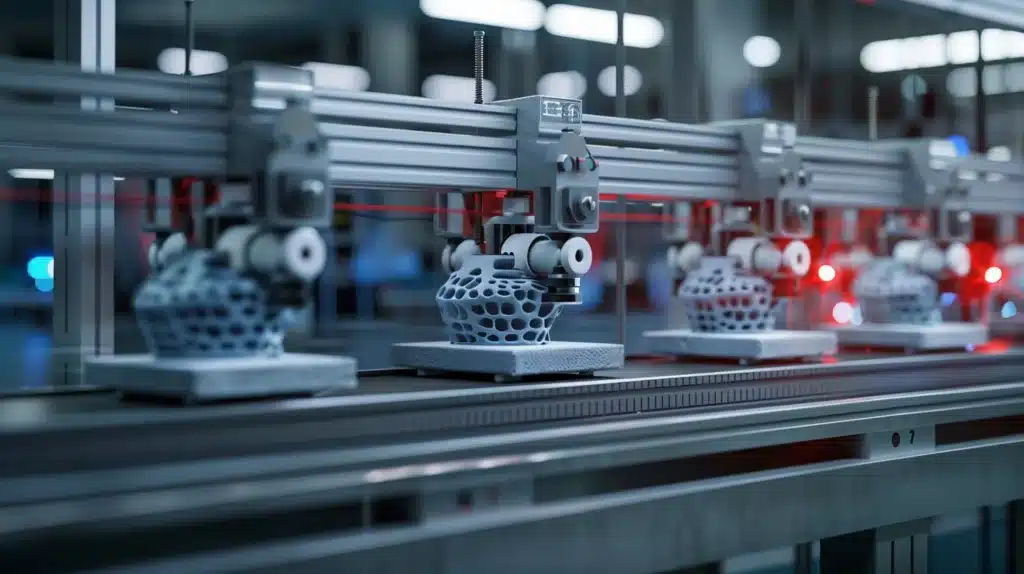For years, engineers and manufacturers have relied on traditional methods like injection molding, machining, and investment casting to produce high-performance plastic and composite parts. These processes, while effective, come with inherent limitations—long lead times, high tooling costs, and design constraints.
Enter high-performance DLP resins—a new breed of 3D printing materials engineered to compete with industrial thermoplastics. No longer limited to prototyping, these resins offer mechanical strength, heat resistance, flexibility, and precision casting, making them viable for functional end-use parts in demanding industries like aerospace, automotive, and medical manufacturing.
EnvisionTEC, a leader in Digital Light Processing (DLP) 3D printing, has pushed resin technology forward, offering materials that rival ABS, polypropylene, glass-filled nylon, and even high-performance PEEK composites. But how do these materials stack up, and where can engineers put them to work?
Let’s break it down.
Hard Plastics: When Strength and Durability Matter
Many engineers hesitate to replace injection-molded plastics with 3D-printed parts, fearing a compromise in strength. But EnvisionTEC’s hard plastic resins challenge this assumption, offering high tensile strength, impact resistance, and heat deflection temperatures comparable to traditional thermoplastics.
How Do These Resins Compare to Industrial Plastics?
| Material | Comparable Thermoplastic | Tensile Strength (MPa) | Elongation (%) | HDT (°C) | Ideal Application |
| E-RigidForm | Polyurethane | 73 | 6 | 63 | Rigid housings, enclosures, tooling |
| Loctite E-3843 | ABS | 60 | 47 | 56 | Load-bearing functional parts, electronics |
| Loctite IND 405 | Polypropylene (PP) | 52 | 127 | 53 | Lightweight fixtures, high-production tools |
| E-GFP | Glass-Filled Nylon | 89 | 6 | 120 | Electrical connectors, industrial jigs |
Where Engineers Are Using Hard Plastic Resins
- Aerospace manufacturers are leveraging E-GFP to replace machined glass-filled nylon in lightweight yet strong structural components.
- Medical device companies are adopting Loctite E-3843 for impact-resistant casings with excellent durability.
- Automotive designers are turning to Loctite IND 405 for jigs and fixtures that must withstand stress but remain lightweight.
For engineers needing rigidity and strength without tooling costs, hard plastic resins are a serious contender.
High-Temperature Resins: Built for Extreme Conditions
Thermoplastics like PEEK and high-performance ABS have long dominated applications requiring heat resistance. But EnvisionTEC’s high-temperature resins offer heat deflection temperatures up to 300°C, making them viable for aerospace interiors, under-the-hood automotive parts, and industrial tools exposed to high heat.
How Do These Materials Handle Heat?
| Material | Comparable Thermoplastic | Tensile Strength (MPa) | HDT (°C) | Compliance | Best Use Cases |
| E-Perform | Ceramic-Filled PEEK | 87 | 160 | – | Aerospace tooling, wind tunnel components |
| Loctite IND406 | ABS, PP | 55 | 107 | – | Industrial enclosures, automotive components |
| Loctite 3955 | Aerospace-Grade Polymer | 66 | 300 | UL94 V-0, Airbus FST | Aerospace and rail interiors |
Where Engineers Are Applying High-Temp Resins
- Wind tunnel engineers are printing E-Perform parts for high-temperature airflow testing, eliminating the need for expensive machining.
- Rail industry manufacturers are adopting Loctite 3955 to meet flame-retardancy regulations while reducing part weight.
- Automotive engineers are replacing metal brackets with Loctite IND406, ensuring durability under extreme heat while cutting production costs.
These resins prove that high-performance 3D printing isn’t just about convenience—it’s about pushing the boundaries of what’s possible in extreme environments.
Elastomeric Resins: Flexible and Impact-Resistant Solutions
Soft-touch materials have long been the domain of silicone and TPU, but printing complex elastomeric parts has been challenging—until now. EnvisionTEC’s Elastic ToughRubber™ series provides rubber-like flexibility with industrial durability, making it a game-changer for shock absorption, gaskets, and wearables.
How Do These Elastomers Compare?
| Material | Hardness (Shore A) | Tear Strength (kN/m) | Elongation (%) | Best Uses |
| Elastic ToughRubber™ 70 | 70 | 31 | 400 | Seals, medical wearables, impact-resistant parts |
| Elastic ToughRubber™ 90 | 90 | 38 | 190 | Automotive bushings, industrial gaskets |
Where Engineers Are Using Flexible Resins
- Medical device manufacturers are creating custom-fit patient wearables using Elastic ToughRubber™ 70.
- Automotive engineers are replacing traditional rubber bushings and dampers with Elastic ToughRubber™ 90 for improved shock absorption.
- Electronics manufacturers are using DLP elastomers for soft-touch, impact-resistant casings.
For applications requiring durability with flexibility, elastomeric resins deliver.
Investment Casting Resins: Precision in Metal Fabrication
Lost-wax casting has been a staple in metal part production for centuries, but castable 3D printing resins are making it faster, more precise, and more cost-effective. With high wax content and clean burnout, EnvisionTEC’s EasyCast 2.0 and WIC100 Series enable high-resolution metal part production.
Where Engineers Are Using Castable Resins
- Aerospace and industrial manufacturers are casting high-strength metal parts with intricate geometries using WIC100 Series.
- Jewelry designers are printing ultra-fine designs in EasyCast 2.0 for precise metal casting.
- Dental labs are adopting castable resins for perfect-fit crowns and bridges without costly machining.
Conclusion: The Future of Industrial Manufacturing is Here
Engineers no longer have to choose between the speed of 3D printing and the performance of traditional materials. EnvisionTEC’s DLP resins deliver strength, heat resistance, flexibility, and precision casting, making additive manufacturing a viable alternative to injection molding, machining, and metal casting.
Find the Right Resin for Your Next Project
If you’re looking to integrate high-performance resins into your manufacturing workflow, contact RapidMade to explore the best material solutions for your needs. Whether you’re working in aerospace, automotive, medical, or industrial manufacturing, the right resin can elevate your production capabilities today.
